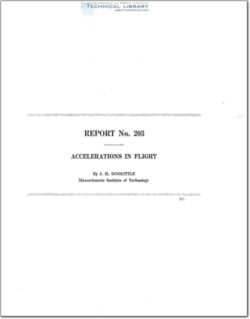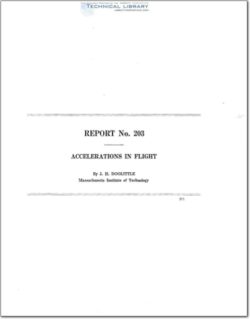naca-report-203

- Version
- 57 Downloads
- 1.51 MB File Size
- 1 File Count
- April 19, 2016 Create Date
- April 19, 2016 Last Updated
National Advisory Committee for Aeronautics, Report - Acceleration in Flight

This work on accelerometry was done at. 1McCook Field in March, 1924, for the purpose
of continuing the work done by other investigators and obtaining the accelerations which occur
when a modern high-speed pursuit airplane is subjected to the more common maneuvers. The
results are presented in this form for publication as a technical report of the National Advisory
Committee for Aeronautics.
The accelerations in suddenly pulling out of a dive are greater than those due to any
maneuver started at the same speed.
The accelerations obtained in suddenly pulling out of a dive with a modern high-speed
pursuit airplane equipped with well-balanced elevators are shown to be within 3 or 4 per cent
of the theoretically possible accelerations. How close this agreement would be in the case of
a similar airplane equipped with unbalanced elevators would be determined by additional
experiments.
Accelerations due to flying the airplane in average “rough air” do not exceed 2.5 g.
The maximum acceleration which a pilot can withstand depends upon the length of time
the acceleration is continued. It is shown that the pilot experiences no difficulty under the
instantaneous accelerations as high as 7.8 92, but that under aCcelerations in excess of 4.5 9.,
continued for several seconds, the pilot quickly loses his faculties. While this is disconcerting
to the pilot, it is not necessarily dangerous for one in good physical condition unless continued
for a. period of 10 to 12 seconds.
The accelerometer was calibrated by securing it to the flywheel of a steam engine, which
gave substantially constant speed for a given throttle setting. Since the wheel revolved in a
vertical plane, the instrument traced out’a’sine curve of amplitude 2 9. Three runs were made
with the instrument in the position to give positive accelerations, and one with the instrument
inverted, to give negative accelerations. Eight points on the calibration curve were obtained
from those runs.
| File | Action |
|---|---|
| naca-report-203 Acceleration in Flight.pdf | Download |

Comment On This Post